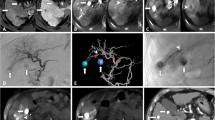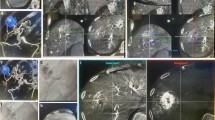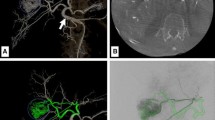Abstract
Purpose
To analyze the technical success and tumor response of ultraselective transcatheter arterial chemoembolization (TACE) for small hepatocellular carcinoma (HCC) using automated tumor-feeders detection (AFD) software.
Methods
Prototype AFD software was prospectively applied to cone-beam computed tomography images acquired during TACE for 155 consecutive HCCs ≤50 mm in 81 patients. The detectability of tumor-feeding subsubsegmental arteries was analyzed. Technical success of TACE was classified into three grades according to 1-week CT; the tumor was embolized with a safety margin (5 mm wide for tumors <25 mm, and 10 mm wide for tumors ≥25 mm) (grade A), without a margin in parts (grade B), or the entire tumor was not embolized (grade C). Tumor response at 2–3 months after TACE was also evaluated in 71 patients using the modified Response Evaluation Criteria in Solid Tumors.
Results
One-hundred and twenty-eight (82.6%) tumors were classed as grade A, 17 (11%) as grade B, and 10 (6.5%) as grade C. AFD software could identify 211 (85.4%) of 247 tumor-feeders but not 36 (14.6%). Eighteen (7.9%) were false positive. The tumor response of target lesions in each patient was complete response (CR) in 49 (69%) patients, partial response (PR) in 19 (26.8%), and stable disease (SD) in 3 (4.2%). The overall tumor response was CR in 39 (54.9%) patients, PR in 15 (21.2%), SD in 1 (1.4%), and progressive disease in 16 (22.5%).
Conclusions
AFD software has sufficient performance to identify tumor-feeders and contributes to the high technical success in ultraselective TACE.







Similar content being viewed by others
References
Lo CM, Ngan H, Tso WK, et al. (2002) Randomized controlled trial of transarterial lipiodol chemoembolization for unresectable hepatocellular carcinoma. Hepatology 35:1164–1171
Llovet JM, Real MI, Montaña X, et al. (2002) Arterial embolisation or chemoembolization versus symptomatic treatment in patients with unresectable hepatocellular carcinoma: a randomised controlled trial. Lancet 359:1734–1739
Yamada R, Sato M, Kawabata M, et al. (1983) Hepatic artery embolization in 120 patients with unresectable hepatoma. Radiology 148:397–401
Uchida H, Ohishi H, Matsuo N, et al. (1990) Transcatheter hepatic segmental arterial embolization using Lipiodol mixed with an anticancer drug and Gelfoam particles for hepatocellular carcinoma. Cardiovasc Intervent Radiol 13:140–145
Matsui O, Kadoya M, Yoshikawa J, et al. (1993) Small hepatocellular carcinoma: treatment with subsegmental transcatheter arterial embolization. Radiology 188:79–83
Miyayama S, Matsui O, Yamashiro M, et al. (2007) Ultraselective transcatheter arterial chemoembolization with a 2-F tip microcatheter for small hepatocellular carcinomas: relationship between local tumor recurrence and visualization of the portal vein with iodized oil. J Vasc Interv Radiol 18:365–376
Iwamoto S, Yamaguchi T, Hongo O, Iwamoto H, Sanefuji H (2010) Excellent outcomes with angiographic subsegmentectomy in the treatment of typical hepatocellular carcinoma: a retrospective study of local recurrence and long-term survival rates in 120 patients with hepatocellular carcinoma. Cancer 116:393–399
Rossi S, Di Stasi M, Buscarini E, et al. (1996) Percutaneous RF interstitial thermal ablation in the treatment of hepatic cancer. Am J Roentgenol 167:759–768
Tateishi R, Shiina S, Teratani T, et al. (2005) Percutaneous radiofrequency ablation for hepatocellular carcinoma: an analysis of 1000 cases. Cancer 103:1201–1209
Miyayama S, Mitsui T, Zen Y, et al. (2009) Histopathological findings after ultraselective transcatheter arterial chemoembolization for hepatocellular carcinoma. Hepatol Res 39:374–381
Deschamps F, Solomon SB, Thornton RH, et al. (2010) Computed analysis of three-dimensional cone-beam computed tomography angiography for determination of tumor-feeding vessels during chemoembolization of liver tumor: a pilot study. Cardiovasc Intervent Radiol 33:1235–1242
Miyayama S, Yamashiro M, Hashimoto M, et al. (2013) Identification of small hepatocellular carcinoma and tumor-feeding branches with cone-beam CT guidance technology during transcatheter arterial chemoembolization. J Vasc Interv Radiol 24:501–508
Iwazawa J, Ohue S, Hashimoto N, Muramoto O, Mitani T (2013) Clinical utility and limitations of tumor-feeder detection software for liver cancer embolization. Eur J Radiol 82:1665–1671
Sasaki A, Kai S, Iwashita Y, et al. (2005) Microsatellite distribution and indication for locoregional therapy in small hepatocellular carcinoma. Cancer 103:299–306
Lencioni R, Llovet JM (2010) Modified RECIST (mRECIST) assessment for hepatocellular carcinoma. Semin Liver Dis 30:52–60
Morimoto M, Numata K, Sugimori K, et al. (2007) Successful initial ablation therapy contributes to survival in patients with hepatocellular carcinoma. World J Gastroenterol 13:1003–1009
Hirota S, Nakao N, Yamamoto S, et al. (2006) Cone-beam CT with flat-panel-detector digital angiography system: early experience in abdominal interventional procedures. Cardiovasc Intervent Radiol 29:1034–1038
Kakeda S, Korogi Y, Ohnari N, et al. (2007) Usefulness of cone-beam volume CT with flat panel detectors in conjunction with catheter angiography for transcatheter arterial embolization. J Vasc Interv Radiol 18:1508–1516
Miyayama S, Matsui O, Yamashiro M, et al. (2009) Detection of hepatocellular carcinoma by CT during arterial portography using a cone-beam CT technology: comparison with conventional CTAP. Abdom Imaging 34:502–506
Miyayama S, Yamashiro M, Okuda M, et al. (2011) Detection of corona enhancement of hypervascular hepatocellular carcinoma by C-arm dual-phase cone-beam CT during hepatic arteriography. Cardiovasc Intervent Radiol 34:81–86
Miyayama S, Yamashiro M, Hattori Y, et al. (2011) Efficacy of cone-beam computed tomography during transcatheter arterial chemoembolization for hepatocellular carcinoma. Jpn J Radiol 29:371–377
Miyayama S, Yamashiro M, Okuda M, et al. (2009) Usefulness of cone-beam computed tomography during ultraselective transcatheter arterial chemoembolization for small hepatocellular carcinomas that cannot be demonstrated on angiography. Cardiovasc Intervent Radiol 32:255–264
Iwazawa J, Ohue S, Hashimoto N, Muramoto O, Mitani T (2012) Survival after C-arm CT-assisted chemoembolization of unresectable hepatocellular carcinoma. Eur J Radiol 81:3985–3992
Miyayama S, Yamashiro M, Hashimoto M, et al. (2013) Comparison of local control in transcatheter arterial chemoembolization of hepatocellular carcinoma ≤6 cm with or without intraprocedural monitoring of the embolized area using cone-beam computed tomography. Cardiovasc Intervent Radiol. doi:10.1007/s00270-013-0667-2
Miyayama S, Matsui O, Yamashiro M, et al. (2007) Iodized oil accumulation in the hypovascular tumor portion of early-stage hepatocellular carcinoma after ultraselective transcatheter arterial chemoembolization. Hepatol Int 1:451–459
Matsui O, Ueda K, Kobayashi S, et al. (2002) Intra- and perinodular hemodynamics of hepatocellular carcinoma: CT observation during intra-arterial contrast injection. Abdom Imaging 27:147–156
Iwazawa J, Ohue S, Hashimoto N, Mitani T (2013) Comparison of the number of image acquisitions and procedural time required for transarterial chemoembolization of hepatocellular carcinoma with and without tumor-feeder detection software. Radiol Res Pract. doi:10.1155/2013/580839
Llovet JM, Di Bisceglie AM, Bruix J, et al. (2008) Design and endpoints of clinical trials in hepatocellular carcinoma. J Natl Cancer Inst 100:698–711
Yamakado K, Miyayama S, Hirota S, et al. (2012) Hepatic arterial embolization for unresectable hepatocellular carcinomas: do technical factors affect prognosis? Jpn J Radiol 30:560–566
Zen C, Zen Y, Mitry RR, et al. (2011) Mixed phenotype hepatocellular carcinoma after transarterial chemoembolization and liver transplantation. Liver Transpl 17:943–954
Conflicts of interest
None
Author information
Authors and Affiliations
Corresponding author
Rights and permissions
About this article
Cite this article
Miyayama, S., Yamashiro, M., Ikuno, M. et al. Ultraselective transcatheter arterial chemoembolization for small hepatocellular carcinoma guided by automated tumor-feeders detection software: technical success and short-term tumor response. Abdom Imaging 39, 645–656 (2014). https://doi.org/10.1007/s00261-014-0094-0
Published:
Issue Date:
DOI: https://doi.org/10.1007/s00261-014-0094-0




